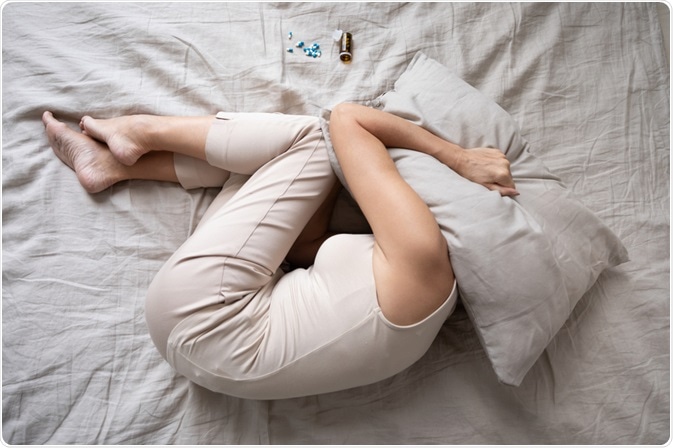Insomnia is the inability to initiate or maintain sleep, or the experience of poor sleep quality.

Image Credit: fizkes / Shutterstock.com
It is reported in about a third of the population in the United States is affected by some form of insomnia, which can have serious consequences that impair daytime functioning. Each type of insomnia has been defined based upon the duration and pattern of sleep disruption.
Middle-of-the-night (MOTN) insomnia affects between 20% to 50% of people, though these individuals may not classify it as a formal sleep disorder. MOTN is short-term when it lasts for less than three months; however, beyond this, the condition becomes chronic.
MOTN is characterized by difficulty in maintaining sleep in one block, resulting in a night-time awakening after several hours of sleep, followed by a significant period of persistent wakefulness before the individual can resume sleep. MOTN is therefore also referred to as difficulty in returning to sleep insomnia.
Health and social risks
Insomnia produces many undesirable effects in those affected, as well as on the society in which the affected individuals live and work. For instance, it is estimated that insomnia is responsible for 50% more healthcare visits, thus contributing to workplace absenteeism and lower productivity.
Insomnia in the elderly also increases the chances of depression, as well as making it more resistant to treatment. The risk of death is also higher in elderly individuals who experience insomnia.
In general, the health of individuals who have MOTN insomnia is slightly worse as compared to those without insomnia, though the difference is small.
Factors affecting MOTN insomnia
MOTN insomnia may be caused or exacerbated by various factors, such as poor sleep hygiene, such as irregular bedtimes, a noisy environment, including leaving the television or radio on, an overfull bladder, or having a bed partner who snores or creates other disturbances during sleep times. Over-intense exercise within two hours of bedtime, as well as the consumption of caffeine late in the evening, can also contribute to the development of MOTN.
In addition to the physical disturbances, the emotional agitation at having been awakened by someone else’s noise can get in the way of falling back to slumber at once. Another factor contributing to the development of MOTN is the low sleep drive at this time because of the previous hours of sleep.
MOTN insomnia is significantly more common in women (approximately 60%) as compared to men, and becomes more frequent with age, though the condition may develop at any age.
MOTN patients have a higher educational status and a higher net income as compared to those with other types of insomnia. In addition, these patients are also more likely to be white, suffer from one or more medical conditions, be unemployed, and drink alcohol.
Tips to deal with those middle of the night bouts of insomnia
Management
In view of the multiple factors affecting sleep, it is important to take a detailed history of the events surrounding bedtime and night-time awakenings. Carefully obtaining the pateint's sleep history is important in understanding the patients’ complaints of both short-term and MOTN insomnia.
Treatment of MOTN insomnia can include cognitive-behavioral therapy (CBT) and pharmacologic modalities.
CBT has been proven to be highly effective in producing both short-term and long-term relief of MOTN insomnia. The drawback is that it requires trained practitioners who are relatively few in comparison to the need. CBT may also not be eligible for reimbursement in certain areas of the world. The lack of widespread availability of CBT in insomnia has led to the greater use of medications instead.
Sleep restriction is a behavioral technique that shows great potential in the treatment of MOTN insomnia. This treatment modality also requires qualified personnel to teach and monitor the therapy, thereby limiting its practical use.
Among pharmaceutical agents, the most commonly used include benzodiazepines, non-benzodiazepines which are gamma-aminobutyric acid (GABA)-agonists, melatonin receptor agonists such as ramelteon, and certain antidepressants, such as trazodone. Antihistamines are used over-the-counter, but they often become ineffective after a short period of time.
Benzodiazepines may also induce tolerance in some patients and also have long half-lives. For this reason, the GABA-ergic drug zolpidem and other drugs in this category are becoming more common, with half-lives of 1 to 4.5 hours. Zolpidem is currently prescribed only if the patient can sleep for 8 or more hours following its use. Sublingual use is believed to be more effective in inducing sleep more quickly and maintaining it.
However, each of these drugs has significant sedating effects the next day, which are particularly important during activities such as driving, or other occupations that require quick reflex times, good muscular coordination, and unimpaired memory. Cognitive problems may thus pose a significant health hazard in terms of lower levels of alertness and muscle responses the morning after or even later, depending on the drug used. Therefore, newer formulations with lower residual sedation are being sought in current research.
References
Further Reading
Last Updated: Apr 26, 2021